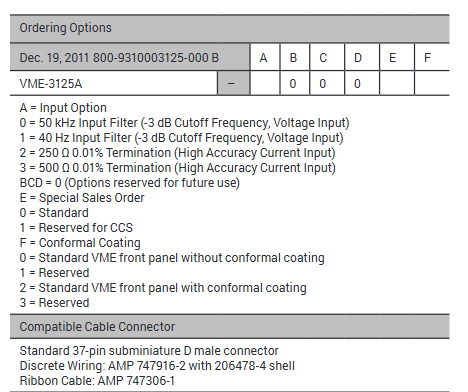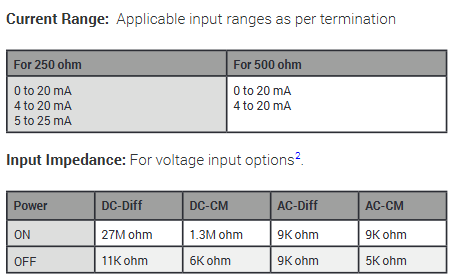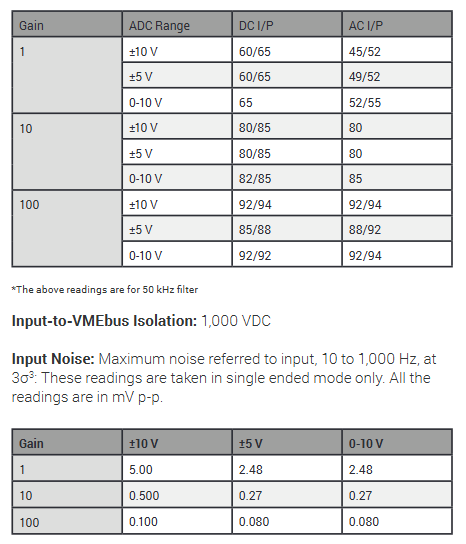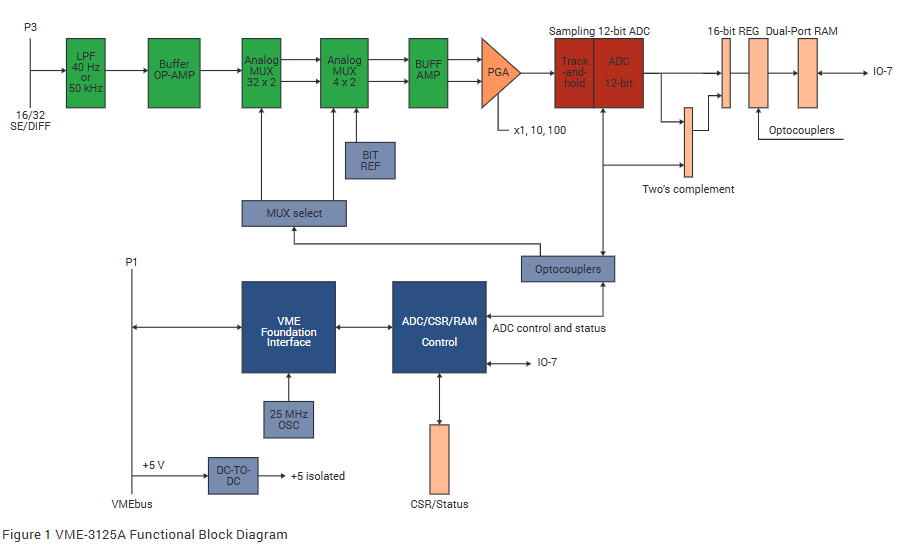

K-WANG


GE VME-3125A Isolation Scan 12 Bit 32 Channel Analog to Digital Converter Board (6U)
Product Name: VME-3125A Isolation Scan 12 Bit 32 Channel Analog to Digital Converter Board (with Built in Testing Function)
Production company: Abaco Systems
Main features
32 single ended or 16 differential inputs
Automatic scanning, continuously digitizing input and storing results in dual port data registers
Input range: Bipolar ± 50mV to ± 10V, Monopolar 0-100mV to 0-10V, or 0 to 25mA current input options
Jumper programmable gains x1, x10, x100
1 12 bit A/D converter with built-in tracking and holding functions
Start scanning without software startup
Pause and lock scanning function, which can achieve 40KSPS arbitrary channel sampling based on channel pointer
Optional A/D range: ± 5V, ± 10V, 0 to+10V
40kHz total conversion rate
Support real-time built-in testing (BIT)
Input connector compatible with discrete and ribbon cables
Optional data encoding: offset binary or binary complement
Over voltage protect
Low pass input filter: 50kHz, optional 40Hz
Pull down resistor to prevent input floating
1000V analog ground/digital ground isolator
GE VME-3125A Isolation Scan 12 Bit 32 Channel Analog to Digital Converter Board (6U)
Basic Information
Product Name: VME-3125A Isolation Scan 12 Bit 32 Channel Analog to Digital Converter Board (with Built in Testing Function)
Production company: Abaco Systems
Main features
32 single ended or 16 differential inputs
Automatic scanning, continuously digitizing input and storing results in dual port data registers
Input range: Bipolar ± 50mV to ± 10V, Monopolar 0-100mV to 0-10V, or 0 to 25mA current input options
Jumper programmable gains x1, x10, x100
1 12 bit A/D converter with built-in tracking and holding functions
Start scanning without software startup
Pause and lock scanning function, which can achieve 40KSPS arbitrary channel sampling based on channel pointer
Optional A/D range: ± 5V, ± 10V, 0 to+10V
40kHz total conversion rate
Support real-time built-in testing (BIT)
Input connector compatible with discrete and ribbon cables
Optional data encoding: offset binary or binary complement
Over voltage protect
Low pass input filter: 50kHz, optional 40Hz
Pull down resistor to prevent input floating
1000V analog ground/digital ground isolator

Ordering Options
Option Description
A (input option) 0=50kHz input filter (-3dB cut-off frequency, voltage input); 1=40Hz input filter (-3dB cut-off frequency, voltage input); 2=250 Ω 0.01% terminal (high-precision current input); 3=500 Ω 0.01% terminal (high-precision current input)
BCD 0 (reserved for future options)
E (Special Sales Order) 0=Standard; 1=Reserved for CCS
F (conforming coating) 0=standard VME front panel without conforming coating; 1=Reserved; 2=Standard VME front panel with conforming coating; 3=Reserved
Compatible cable connectors
Standard 37 pin ultra small D-type male connector
Discrete cabling: AMP 747916-2 (with 206478-4 enclosure)
Ribbon cable: AMP 747306-1
Functional characteristics
1. Basic Introduction
VME-3125A provides isolated 12 bit analog-to-digital conversion with 32 single ended analog voltage input channels (16 differential) for VMEbus's 6U Eurocard. The optional gain and A/D range support an input voltage range of ± 50mV to ± 10V, and the current input option supports 32 single ended channels with ranges of 0 to 20mA, 4 to 20mA, and 5 to 25mA. To minimize system software overhead, all inputs are continuously scanned and digitized at a total sampling rate of 40000 samples per second, and the measurement data of each channel is accessed by VMEbus at any time through a dual port data register. For voltage input, a 40Hz low-pass input filter can be selected to minimize the impact of system noise, and the standard unit is equipped with a 50kHz low-pass filter.
2. Core functions
Programmable Gain Amplifier (PGA): Jumper options include series voltage gain x1, x10, or x100 for all channels; For voltage input, the full range of the A/D converter can be selected as ± 5V, ± 10V, or 0 to+10V; the data encoding software can be selected as offset binary or binary complement code
Input configuration: The input can be configured with 16 differential voltage channels or 32 single ended voltage or current channels through jumper wires; A single front panel 37 pin ultra small D-type connector provides connections for all input channels
Working mode: All 16 or 32 input channels are continuously scanned at the maximum sampling rate, and the resulting data is stored in a dual port data register for VMEbus to access; After any reset operation, the scan automatically starts without the need for additional programming to initiate the A/D conversion process
Built in Test Function (BIT): By selecting the BIT working mode, the operation of PGA, ADC, and related control logic can be verified. In this mode, the internal reference voltage is applied to the input of PGA, bypassing the analog input multiplexer. All data channels read through the control interface will reflect the selected BIT reference voltage
3. Features related to VMEbus
Compliance: Compliant with VMEbus standard ANSI/IEEE STD 1014-1987, IEC 821 and 297, with 6U external dimensions
Board address: The physical address is selected through the onboard address jumper, using VMEbus address lines A07 to A15; The VME-3125A board occupies 128 bytes of address space and can be located on any 64 word boundary of the short I/O (A16) space
Address Modifier: Address modifier bits are selected and decoded through jumpers to respond to non privileged short I/O access, monitoring short I/O access, or both access privileges
4. System reset and indicator lights
System reset: System reset establishes the following board states: all channels automatically scan, front panel diagnostic LED indicator lights up, offset binary data format
Front panel system diagnostic LED: The software controlled front panel LED lights up when the system is reset and can be turned off under software control to provide an external indication that the built-in test has been completed

Simulate input data format
The analog input is digitized and stored in 32 dual port data registers (16 registers for differential operation) as a 12 bit right aligned digital value. The software can select data codes as offset binary and binary complement. In binary complement encoding, the sign bit (D11) is extended to the most significant bit (D12 to D15) of the data register.
Input characteristics
(At+25 ° C and rated power supply, unless otherwise specified)
Number of channels: 32 single ended or 16 differential voltage input channels; 32 single ended current input channels
Voltage range: ± 50mV to ± 10V (bipolar) or 0 to+100mV, 0 to+10V (unipolar), factory configured for ± 10V input range
Current terminal: Suitable for single ended, 0-10V, and X1 gain unipolar configurations, with two options: 250 Ω 0.01% and 500 Ω 0.01%
Current range: According to the applicable input range of the terminal, 250 Ω corresponds to 0 to 20mA, 4 to 20mA, 5 to 25mA; 500 Ω corresponds to 0 to 20mA, 4 to 20mA
Input impedance: When the power is turned on, the voltage input options are DC differential 27M Ω, DC common mode 1.3M Ω, AC differential 9K Ω, and AC common mode 9K Ω. When the power is turned off, the DC differential 11K Ω, DC common mode 6K Ω, AC differential 9K Ω, and AC common mode 5K Ω
Input bias current: minimum 44nA/maximum 90nA
Input bias current drift: 0.30nA/° C
Common mode voltage (CMV): When the differential input is at zero input signal, the maximum ± 11V; CMV refers to the common analog ground of all inputs; For other gains, the formula is ± 11V=(VCM+Vddiff/2) * gain
Common mode rejection ratio (CMRR): Differential input has different minimum/typical values (dB) at different gains and ADC ranges when the source is unbalanced at 350 Ω and the frequency is between DC and 60Hz
Input to VMEbus isolation: 1000VDC
Input noise: Under 10 to 1000Hz and 3 σ, different gains and ranges have different maximum noise (mV p-p) in single ended mode
Each input bandwidth: DC to Fc, where Fc is 50kHz for a 50kHz filter and 40Hz for a 40Hz filter option unit
Input filter: Single pole passive low-pass filter, -3dB at 50kHz or 40Hz ± 20% (voltage input option only)
Overvoltage protection: maximum ± 40V continuous during power supply; ± 25V during power outage

Transmission characteristics
(At+25 ° C and rated power supply, unless otherwise specified)
Measurement resolution: 12 bits
Channel scanning rate: minimum 40KSPS (thousand samples/second) total rate
Voltage transfer function:
E IN=E LO+E FSR × 4096N ADC, where E IN=input voltage, E LO=lower end of input range,
E FSR=full-scale input range, N ADC=A/D converter reading
Current transfer function: I IN=R TERMINATION E FSR × N ADC/4096, where I IN=input current (ampere), E FSR=10V (unipolar), N ADC=A/D converter reading, R TERMINATION=250 Ω or 500 Ω options
Input range of A/D converter: ± 5V, ± 10V, 0 to+10V, jumper optional
Input gain of A/D converter: x1, x10, x100 (± 0.3%, jumper optional)
Accuracy: Voltage input=± 0.04% reading ± 0.03% range ± 2.0mV; Current input (-200, -300 options)=± 0.05% range ± 2.44 μ A
Temperature stability: The voltage input board option (mV/° C) is ± 30PPM reading ± 25PPM range ± 20 μ V; The current input board option (μ A/° C) is ± 40PPM reading ± 25PPM range ± 20nA
Long term drift: ± 50PPM reading ± 45PPM range ± 100 μ V every 1000 hours
Channel crosstalk: In ± 10V bipolar and gain X1 differential mode, different options have different typical/maximum values (dB) for DC and AC inputs
BIT reference voltage: Software options include 0.000V,+4.980V,+0.4928V, and 9.91mV
BIT reference accuracy: ± 30mV ± 30PPM/° C (4.98VDC)
Physical/Environmental Specifications
Size: Standard VME double height board 160 × 233.5mm
Power requirement:+5VDC (± 5%), maximum 1.5A
Temperature: Operating temperature from 0 ° C to+65 ° C; Storage temperature from -40 ° C to+85 ° C
Humidity: Operating relative humidity of 20% to 80%, no condensation
Cooling: forced air convection (standard VME slot)
MTBF: Contact the factory
Input connector (P3): 37 pin ultra small D-type female connector

- YOKOGAWA
- Energy Access
- Renewable Integration
- Energy Subsidies
- Energy and Water
- Net zero emission
- Energy Security
- Critical Minerals
- A-B
- petroleum
- Mine scale
- Energy and Gender
- Covid-19
- man-machine
- Reliance
- ADVANCED
- SEW
- ProSoft
- WATLOW
- Kongsberg
- FANUC
- VSD
- DCS
- PLC
- Sewage treatment
- cement
- Yaskawa
- Woodward
- BOSCH Rexroth
- MOOG
- General Electric
- American NI
- Rolls-Royce
- CTI
- Honeywell
- EMERSON
- Automobile market
- xYCOM
- Motorola
- architecture
- Industrial information
- New energy
- electricity
- Construction site
- HIMA
- ABB
- Rockwell
- Schneider Modicon
- Siemens
- MAN
- GE
- TRICONEX
- Control Wave
- ALSTOM
- AMAT
- STUDER
- KONGSBERG
- MOTOROLA
- DANAHER MOTION
- Bentley
- Galil
- EATON
- MOLEX
- Triconex
- DEIF
- B&W
- ZYGO
- Aerotech
- DANFOSS
- KOLLMORGEN
- Beijer
- Endress+Hauser
- schneider
- Foxboro
- KB
- REXROTH
- YAMAHA
- Johnson
- Westinghouse
- WAGO
- TOSHIBA
- TEKTRONIX
- BENDER
- BMCM
- SMC
- HITACHI
-
BENTLY NEVADA 3500/15 133292-01 Power Supply Module
-
ABB PM877 3BDH000777R1 Central_Unit Controller
-
GE Hydran M2-X Enhanced Monitoring
-
ABB REG316 1mrk000809-GA Numerical Generator Protection
-
ABB RED670 1MRK004810 Line differential protection
-
GE SR750-P5-G5-S5-HI-A20-R-E Feeder protection system
-
ABB PFTL301E-1.0KN 3BSE019050R1000 PillowBlock Load cells
-
Kollmorgen S33GNNA-RNNM-00 - Brushless Servo Motor
-
Kollmorgen 6sm56-s3000-g-s3-1325 - Servo Motor
-
Kollmorgen AKM52K-CCCN2-00 - Servo Motor
-
Kollmorgen PSR3-230/75-21-202 - Power Supply
-
Kollmorgen akm24d-anc2r-00 - Servo Motor
-
Kollmorgen AKM22E-ANCNR-00 - Servo Motor
-
Kollmorgen S60300-550 - Servo Drive
-
Kollmorgen B-204-B-21 - Servomotor
-
Kollmorgen AKM21E-BNBN1-00 - Servo Motor
-
Kollmorgen TT2953-1010-B - DC Servo Motor
-
Kollmorgen pa8500 - Servo Power Supply
-
Kollmorgen BDS4A-210J-0001-207C2 - Servo Drive
-
Kollmorgen TTRB1-4234-3064-AA - DC Servo Motor
-
Kollmorgen MH-827-A-43 - Servo Motor
-
Kollmorgen AKM24D-ACBNR-OO - Servo Motor
-
Kollmorgen 00-01207-002 - Servo Disk DC Motor
-
Kollmorgen AKM21C-ANBNAB-00 - Servo Motor
-
Kollmorgen PSR3-208/50-01-003 - Power Supply
-
Kollmorgen 6SM56-S3000 - Servo Motor
-
Kollmorgen DBL3H00130-B3M-000-S40 - Servo Motor
-
Kollmorgen 6SN37L-4000 - Servo Motor
-
Kollmorgen AKM65K-ACCNR-00 - Servo motor
-
Kollmorgen 6SM56-L3000-G - Servo Motor
-
Kollmorgen AKMH43H-CCCNRE5K - Servo Motor
-
Kollmorgen PSR4/52858300 - Power Supply
-
Kollmorgen KBM-79H03-E03 - Direct Drive Rotary Motor
-
Kollmorgen AKM33E-ANCNDA00 - Servo Motor
-
Kollmorgen U9M4/9FA4T/M23 - ServoDisc DC Motor
-
Kollmorgen AKM13C-ANCNR-00 - Servo Motor
-
Kollmorgen AKM43L-ACD2CA00 - Servo Motor
-
Kollmorgen AKM54K-CCCN2-00 - Servo Motor
-
Kollmorgen M-605-B-B1-B3 - Servo Motor
-
Kollmorgen AKD-P00606-NBAN-0000 - Rotary Drive
-
Kollmorgen 6SM-37M-6.000 - Servo Motor
-
Kollmorgen A.F.031.5 - Sercos Interface Board
-
Kollmorgen 918974 5054 - Servo PWM
-
Kollmorgen U12M4 - ServoDisc DC Motor
-
Kollmorgen AKD-B00606-NBAN-0000 - Servo Drive
-
Kollmorgen MV65WKS-CE310/22PB - Servo Drive
-
Kollmorgen 65WKS-CE310/22PB - Servo Drive
-
Kollmorgen EM10-27 - Module
-
Kollmorgen S64001 - Servo Drive
-
Kollmorgen CR03200-000000 - Servo Drive
-
Kollmorgen 6SM57M-3000+G - Servo Motor
-
Kollmorgen BDS4 - Servo Drive
-
Kollmorgen AKD-P00306-NBEC-000 - Servo Drive
-
Kollmorgen AKD-B01206-NBAN-0000 - Servo Drive
-
Kollmorgen STP-57D301 - Stepper Motor
-
Kollmorgen 6SM37L-4.000 - Servo Motor
-
Kollmorgen 44-10193-001 - Circuit Board
-
Kollmorgen PRDR9SP24SHA-12 - Board
-
Kollmorgen PRD-AMPE25EA-00 - Servo Drive
-
Kollmorgen DBL3N00130-0R2-000-S40 - Servo Motor
-
Kollmorgen S406BA-SE - Servo Drive
-
Kollmorgen AKD-P00607-NBEI-0000 - Servo Drive
-
Kollmorgen AKD-P01207-NBEC-0000 - Servo Drive
-
Kollmorgen CR03550 - Servo Drive
-
Kollmorgen VSA24-0012/1804J-20-042E - Servo Drive
-
Kollmorgen N2-AKM23D-B2C-10L-5B-4-MF1-FT1E-C0 - Actuator
-
Kollmorgen 04S-M60/12-PB - Servo Drive
-
Kollmorgen H33NLHP-LNW-NS50 - Stepper Motor
-
Kollmorgen A-78771 - Interlock Board
-
Kollmorgen AKM43E-SSSSS-06 - Servo Motor
-
Kollmorgen AKD-P00607-NBEC-0000 - Servo Drive
-
Kollmorgen E21NCHT-LNN-NS-00 - Stepper Motor
-
Kollmorgen cr10704 - Servo Drive
-
Kollmorgen d101a-93-1215-001 - Motor
-
Kollmorgen BDS4A-203J-0001-EB202B21P - Servo Drive
-
Kollmorgen MCSS23-6432-002 - Connector
-
Kollmorgen AKD-P01207-NACC-D065 - Servo Drive
-
Kollmorgen CK-S200-IP-AC-TB - I/O Adapter and Connector
-
Kollmorgen CR10260 - Servo Drive
-
Kollmorgen EC3-AKM42G-C2R-70-04A-200-MP2-FC2-C0 - Actuator
-
Kollmorgen BDS5A-206-01010-205B2-030 - Servo Drive
-
Kollmorgen s2350-vts - Servo Drive
-
Kollmorgen AKM24D-ANC2DB-00 - Servo Motor
-
Kollmorgen E31NCHT-LNN-NS-01 - Stepper Motor
-
Kollmorgen PRD-0051AMPF-Y0 - Servo Board
-
Kollmorgen TB03500 - Module
-
Kollmorgen 60WKS-M240/06-PB - Servo Drive
-
Kollmorgen M21NRXC-LNN-NS-00 - Stepper Motor
-
Kollmorgen H-344H-0212 - Servo Motor
-
Kollmorgen MCSS08-3232-001 - Connector
-
Kollmorgen AKM33H-ANCNC-00 - Servo Motor
-
Kollmorgen PA-2800 - Power Supply
-
Kollmorgen MTC308C1-R1C1 - Servo Motor
-
Kollmorgen PRDR0091300Z-00 - Capacitor Board
-
Kollmorgen BDS4A-206J-0024/01502D79 - Servo Drive
-
Kollmorgen S20330-VTS - Servo Drive
-
Kollmorgen S20250-CNS - Servo Drive
-
Kollmorgen SBD2-20-1105-WO - Servo Drive Board
-
Kollmorgen M405-C-A1--E1 - Servo Motor
-
Kollmorgen PRD-PB805EDD-00 - Servo Drive
-
Kollmorgen 6SM57S-3.000-J-09-HA-IN - Servo Motor
-
Kollmorgen AKM33H-ANCNDA-00 - Servo Motor
-
Kollmorgen PCB-00030200-04 - PCB
-
Kollmorgen H22SSLB-LNN-NS-02 - Stepper Motor
-
Kollmorgen BJRL-20012-110001 - Module
-
Kollmorgen BDS4A-206J-0001404A - Servo Drive
-
Kollmorgen H-342-H-0802 - Servo Motor
-
Kollmorgen CR10561 - Servo Drive
-
Kollmorgen BDS5A-206-00010-205B2-030 - Servo Drive
-
Kollmorgen BDS5A-206-00010-207B-2-030 - Servo Drive
-
Kollmorgen mcss08-3224-001 - Connector
-
Kollmorgen M-207-B-23-B3 - Servo Motor
-
Kollmorgen PRD-0041200Z-S0 - Encoder/Resolver Card
-
Kollmorgen MH-225-G-61 - Motor
-
Kollmorgen MT308B1-T1C1 - Servo Motor
-
Kollmorgen BDS4A-240J-0001604C83 - Servo Drive
-
Kollmorgen 6SM57-S-3000 - Servo Motor
-
Kollmorgen N-T31V-15-5B-6-MF3-FT1E-C251 - Actuator
-
Kollmorgen PRD-0051AMPA-X0 - Servo Board
-
Kollmorgen CF-SS-RHGE-09 - Cable
-
Kollmorgen DIGIFAS7204 - Servo Drive
-
Kollmorgen S30101-NA - Servo Drive
-
Kollmorgen DIGIFAS7201 - Servo Drive
-
Kollmorgen PRD-0051AMPA-Y0 - Servo Board
-
Kollmorgen AKM23D-EFCNC-00 - Servo Motor
-
Kollmorgen SE10000 - Servo Drive
-
Kollmorgen PSR4/5A-112-0400 - Power Supply
-
Kollmorgen AKM31H-ANCNC-01 - Servo Motor




